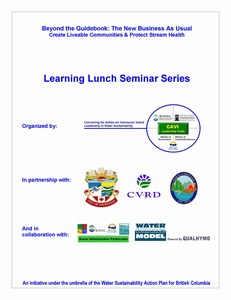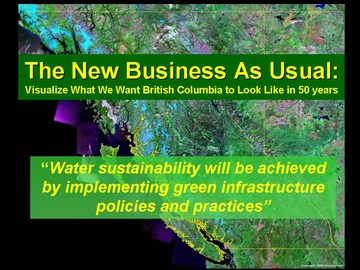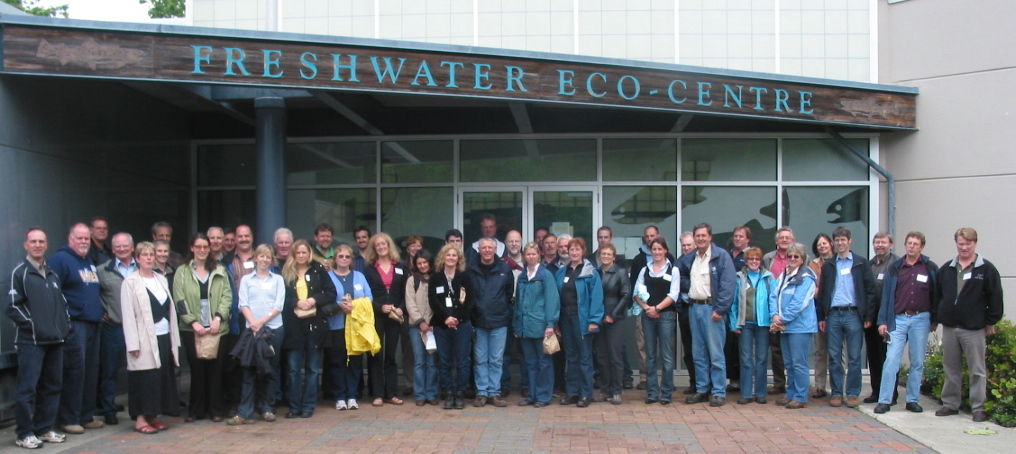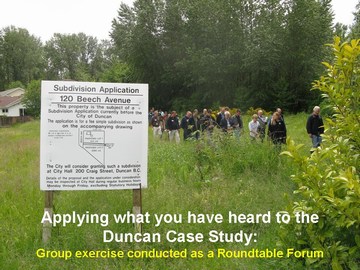Cowichan Valley Learning Lunch Seminar #2 – focus on legal and policy strategies
Educational process sets stage for regional green infrastructure policy framework
The Learning Lunch Seminar Series is the first step in building a regional team approach in the Cowichan Valley so that there will be consistency regarding rainwater management and green infrastructure. This provincial initiative builds on the foundation provided by Stormwater Planning: A Guidebook for British Columbia, published in 2002, and incorporates experience gained over the past six years in moving from planning to action.
the past six years in moving from planning to action.
The second of three sessions in the Cowichan Valley Series was held on June 20, 2008 at the Freshwater Eco-Centre in Duncan. The seminar was attended by inter-departmental representatives of all five member local governments (i.e. Cowichan Valley Regional District, North Cowichan, Duncan, Ladysmith and Lake Cowichan). An inter-regional flavour was added through the participation of representatives of two provincial ministries, the Regional District of Nanaimo, and the cities of Courtenay and Nanaimo.
Learning Outcomes
The Stormwater Planning Guidebook set in motion a chain of outcomes that has resulted in British Columbia being recognized internationally as a leader in implementing a natural systems approach to rainwater management in the urban environment. To develop a common understanding of what this means in practice, Seminar #2 was structured in three parts, with learning outcomes identified as follows:
PART ONE: What tools available are under the Local Government Act to manage the rainfall spectrum.
 Kim Stephens opened by providing a frame of reference for the day. To download a copy of the presentation, click here or on the image below. He emphasized the importance of looking beyond the 3-part series and determining what role each individual can play in ‘creating our future’. To view a video clip of Kim’s opening remarks, please click here or on the adjacent image.
Kim Stephens opened by providing a frame of reference for the day. To download a copy of the presentation, click here or on the image below. He emphasized the importance of looking beyond the 3-part series and determining what role each individual can play in ‘creating our future’. To view a video clip of Kim’s opening remarks, please click here or on the adjacent image.
Legislative Overview:
Susan Rutherfordof West Coast Environmental Law Foundation (and representing the Green Infrastructure Partnership) summarized opportunities and scales for law and policy to  affect change. Her presentaton was titled Effective Municipal Rainwater/Stormwater Management and Green Infrastructure to Achieve Watershed Health. To download a copy of the presentation, click here or on the image below. In addition to providing a legislative context, this set the stage for Kevin Lagan and Derek Richmond to talk about on-the-ground case study applications in the City of Courtenay.
affect change. Her presentaton was titled Effective Municipal Rainwater/Stormwater Management and Green Infrastructure to Achieve Watershed Health. To download a copy of the presentation, click here or on the image below. In addition to providing a legislative context, this set the stage for Kevin Lagan and Derek Richmond to talk about on-the-ground case study applications in the City of Courtenay.
City of Courtenay Case Study Applications:
Kevin Lagan, Director of Operational Services for the City of Courtenay,  provided an overview of Lessons Learned on Soil Depth as a result of Courtenay being the first municipality in British Columbia to adopt a policy for ensuring a ‘soil sponge’ on development sites. To view a video clip of Kevin elaborating on his slides, please click here. To download a copy of his presentation, click here or on the image below.
provided an overview of Lessons Learned on Soil Depth as a result of Courtenay being the first municipality in British Columbia to adopt a policy for ensuring a ‘soil sponge’ on development sites. To view a video clip of Kevin elaborating on his slides, please click here. To download a copy of his presentation, click here or on the image below.
Derek Richmond, Manager of Engineering for the City of Courtenay, then elaborated on why and how the City is approaching implementation of its Erosion and Sediment Control Bylaw via an inclusive and collaborative process. To download a copy of his presentation, click here or on the image below.

To view and hear Derek explaining the process that the City has followed in developing the bylaw, please click here for the first of two video clips. To view Derek elaborate on bylaw implementation in the second of two video clips, please click here.
PART TWO: How engineered green infrastructure is being incorporated into land development projects to protect stream health.
Marlene Caskey and Maggie Henigman of the Ministry of Environment talked about the Develop with Care provincial initiative, To download a copy of their tag-team presentation, click here or on the image below. They emphasized the importance of preserving intact functioning ecosystems as an integral part of the strategy for addressing overall climate change and water wise issues.
Develop with Care: Environmental Guidelines for Urban and Rural Land Development in British Columbia:
“The document is intended to assist people who are involved in planning, implementing, reviewing and/or approving land developments in British Columbia’s urban and rural areas. Its primary purpose is to provide province-wide guidelines for the maintenance of environmental values during the development of urban and rural lands,” stated Marlene Caskey.
“It also provides information on ways that environmental protection and stewardship can benefit the community, the property owner and the developer, as well as the natural environment,” added Maggie Henigman. To view a video clip of Marlene Caskey setting the context and explaining the objectives for the Develop with Care program, please  click here. After that, watch Maggie Henigman elaborate on climate change implications as she underscores what is at risk on Vancouver Island. In a third and final video clip, Marlene and Maggie tag-team to describe the four principles that show “how to get there” in terms of achieving shared environmental goals.
click here. After that, watch Maggie Henigman elaborate on climate change implications as she underscores what is at risk on Vancouver Island. In a third and final video clip, Marlene and Maggie tag-team to describe the four principles that show “how to get there” in terms of achieving shared environmental goals.
PART THREE: How to use the 2007 Green Infrastructure Guide as a planning resource and/or tool.
In her second presentation, Susan Rutherford provided a synopsis of Chapters 2 (Rain and Land) and 5 (Liability) in the Green Infrastructure Guide because of their particular relevance to the seminar curriculum. To download a copy, click here or on the image below.
To view a video clip of Susan reviewing the tools available to local government to encourage or require low impact designs as well as the finding of innovative alternatives and solutions to achieve the New Business As Usual, please click here. In a second video clip, Susan elaborates on “the elephant liability” by painting a picture of the many kinds of risk that enter into a local government’s consideration of a project or infrastructure innovation. Click here to view the video clip.
Kim Stephens wrapped up the day by foreshadowing how seminar participants would be walked through an example application of the Water Balance Model as part of the program for Seminar #3. The vision for this web-based decision support tool is that it will help communities create neighbourhoods that integrate both good planning and innovative engineering designs, for overall greater sustainability (environmental, social, economic).
The Elephant in the Living Room
Released by Environment Minister Barry Penner on June 3rd 2008, Living Water Smart will change the way British Columbians do business around water. Of relevance to the curriculum for the Learning Lunch Seminar Series, Living Water Smart provides the over-arching policy framework for Beyond the Guidebook: The  New Business As Usual. Kate Miller used the analogy of the ‘elephant in the living room’ to illustrate why and how the Cowichan Valley Regional District and CIty of Courtenay have seized the opportunity to show provincial leadership in co-sponsoring the Learning Lunch Seminar Series. To watch a video clip of Kate’s explanation, please click here or on the image below.
New Business As Usual. Kate Miller used the analogy of the ‘elephant in the living room’ to illustrate why and how the Cowichan Valley Regional District and CIty of Courtenay have seized the opportunity to show provincial leadership in co-sponsoring the Learning Lunch Seminar Series. To watch a video clip of Kate’s explanation, please click here or on the image below.
The ‘elephant in the living room’ was created by Banksy, the famed British graffiti artist. The elephant has been made to stand in a makeshift living room, to blend in to its surroundings. Banksy is thought to be making a point about poverty and other important issues which he believes are ignored despite their enormous impact on so many lives.
In elaborating on the story behind the image, Kate Miller told the Learning Lunch audience that “there is an elephant in our room right now…which is around how do we deal with rainwater management…how do we deal with the larger policy issues…what’s the objective.”
City of Duncan Case Study
To ground the Learning Lunch Seminar Series in reality, a 2-lot subdivision in the City of Duncan serves as a case study. Click here or on the image below to view a video clip that provides background on the property in question. A breakout group exercise provided participants with an opportunity to brainstorm how they would apply what they had learned during the day.
To view a video clip of David Hewetson (and Kate Miller) explaining expectations ![]() and the rules of engagement for the breakout session, please click here. To learn what each of the four breakout groups concluded, click on this link to the reporting out segment.
and the rules of engagement for the breakout session, please click here. To learn what each of the four breakout groups concluded, click on this link to the reporting out segment.
Series Overview
 “Each session in the Learning Lunch Seminar Series starts at 11:00am and ends at 2:30pm,” notes Peter Nilsen. “Our experience is that this is the right length of time to maintain the interest and energy level of participants. Three and a half hours sounds like a lot of time, but it goes quickly; and we were just scratching the surface in terms of the material that we presented.”
“Each session in the Learning Lunch Seminar Series starts at 11:00am and ends at 2:30pm,” notes Peter Nilsen. “Our experience is that this is the right length of time to maintain the interest and energy level of participants. Three and a half hours sounds like a lot of time, but it goes quickly; and we were just scratching the surface in terms of the material that we presented.”
“The series comprises three sessions that provide an inter-departmental learning opportunity for collaborative exploration. The series is conducted as a cumulative process, from philosophy to tools,” reports Kate Miller.
“ By spreading the curriculum over three sessions, this enables participants to absorb the new information, blend it with their own experience, and eventually apply it in making decisions,” notes Kim Stephens. To view a video clip of the perspective Kim provided in wrapping up the day, click here or on the adjacent image.
By spreading the curriculum over three sessions, this enables participants to absorb the new information, blend it with their own experience, and eventually apply it in making decisions,” notes Kim Stephens. To view a video clip of the perspective Kim provided in wrapping up the day, click here or on the adjacent image.
For more detailed information on the series design, please click on the following link to download a copy of the Program Outline for Learning Lunch Seminar Series. The theme and scope of each session are summarized below:
Today’s Expectations are Tomorrow’s Standards:
Session #1 traces the evolution of rainwater/stormwater management policies and practices over the past decade. This provides a frame-of-reference and a common understanding for subsequent sessions.
Legal and Policy Strategies to Support Green Infrastructure:
Session #2 introduces the extensive and very specific tools available under the Local Government Act so that they can proactively manage the complete spectrum of rainfall events: from light showers to heavy rain to extreme storms.
Establishing Watershed Performance Targets:
Session #3 introduces a performance target approach to land development that makes sense, meets multiple objectives, is affordable, and results in net environmental benefits at a watershed scale.
PowerPoint Presentations
By listening to the audio for a video clip while viewing the slides, this should provide a reasonable impression of what was said by each speaker, and in what context.
- Kim Stephens
PowerPoint: Building local government capacity
Video Clip: Setting the Scene for the Day - Susan Rutherford (1st of two)
PowerPoint: Effective Municipal Rainwater/Stormwater Management to Achieve Watershed Health
Video Clip: An Introduction to the Green Infrastructure Guide - Kevin Lagan
PowerPoint: Lessons Learned on Soil Depth
Video Clip: City of Courtenay – Lessons Learned on Soil Depth - Derek Richmond
PowerPoint: Erosion and Sediment Control Bylaw
Video Clip #1: City of Courtenay – Erosion & Sediment Control Bylaw: The Process
Video Clip #2: City of Courtenay – Eriosion & Sediment Control Bylaw: Implementation - Marlene Caskey & Maggie Henigman
PowerPoint: Develop with Care
Video Clip #1: Develop with Care: Program Objectives
Video Clip #2: Develop with Care: Climate Change Implications
Video Clip #3: Develop with Care: How to Get There - Susan Rutherford (2nd of two)
PowerPoint: An Introduction to the Green Infrastructure Guide
Video Clip #1: An Introduction to the Green Infrastructure Guide
Video Clip #2: Old versus New Business As Usual: Risk and Liability
Resources
To download copies of resource materials that comprise the curriculum for the Learning Lunch Seminar Series, click on each of the images below:
Video Clips
By listening to the audio for a video clip while viewing the slides (see list above), this should provide a reasonable impression of what was said by each speaker, and in what context.
- Setting the Scene for the Day
- City of Courtenay – Lessons Learned on Soil Depth
- City of Courtenay – Erosion & Sediment Control Bylaw: The Process
- City of Courtenay – Eriosion & Sediment Control Bylaw: Implementation
- Develop with Care: Program Objectives
- Develop with Care: Climate Change Implications
- Develop with Care: How to Get There
- An Introduction to the Green Infrastructure Guide
- Old versus New Business As Usual: Risk and Liability
- The Elephant in the Room
- Breakout Session: case study context
- Breakout Session: rules of engagement
- Breakout Session: reporting out
- Closing Remarks: Educational Objectives
Posted June 2008

















